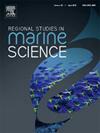Reproductive cycle of Mytilus galloprovincialis (Lamarck, 1819) and Perna perna (Linné, 1758) for sustainable exploitation of natural mussel beds in Massa-Tifnit (On the Moroccan Atlantic Coast)
IF 2.1
4区 环境科学与生态学
Q3 ECOLOGY
引用次数: 0
Abstract
The reproductive cycles of the mussel species Mytilus galloprovincialis and Perna perna, were studied at three sites on the Atlantic coast of southern Morocco (Sidi R′bat, Douira and Tifnit). Monitoring of temporal variations in the condition index, gonadal index and histological analyses of the gonadal maturity stages and sex ratio was conducted monthly, from January to December 2018.
The results indicate that the sex ratio favored males in both species, with a maximum ratio of 1.9: 0.53 for M. galloprovincialis at Tifnit; in contrast, the P. perna population at Tifnit presented a female-dominated ratio of 0.84:1.19. The spawning event for M. galloprovincialis occurred over three periods: two primary spawning periods in spring and autumn, and a secondary period in winter. P. perna spawns all year, with a primary spawning period from spring to autumn and several secondary spawning events. A small number of individuals (undifferentiated) were found in the sexual resting stage, recorded mainly in July and August. The variation in the condition index and gonadal index confirmed the periods of reproduction and the nutritive status of the bivalves.
The aim of this work is to contribute to a better understanding of mytiliculture potential by studying the reproductive cycle and recruitment of M. galloprovincialis and P. perna in their natural populations. Additionally, it supports the development of conservation and protection measures to sustain healthy populations and ensure sustainable fishing yields. Our results indicate that the mussel beds in this region possess several characteristics that make them suitable for aquaculture development.
摩洛哥大西洋沿岸Massa-Tifnit天然贻贝床可持续开发的Mytilus galloprovincialis (Lamarck, 1819)和Perna Perna (linn, 1758)的生殖周期
在摩洛哥南部大西洋沿岸的三个地点(Sidi R 'bat、Douira和Tifnit)研究了贻贝物种Mytilus galloprovincialis和Perna Perna的繁殖周期。2018年1月至12月,每月监测状态指数、性腺指数的时间变化,并对性腺成熟期和性别比进行组织学分析。结果表明,两种植物的性别比均倾向于雄性,在蒂尼特,加洛省田鼠的性别比最高为1.9:0.53;而在蒂芬尼特,雌优势比为0.84:1.19。黄花栗鼠的产卵活动分三个阶段进行:春季和秋季两个初级产卵期和冬季一个次级产卵期。白杨全年产卵,主要产卵期为春季至秋季,并有几次产卵事件。在性休止期发现少量个体(未分化),主要记录在7、8月。状态指数和性腺指数的变化证实了双壳类动物的繁殖周期和营养状况。本研究的目的是通过研究黄毛霉和紫毛霉在其自然种群中的繁殖周期和招募情况,为更好地了解紫毛霉的栽培潜力做出贡献。此外,它还支持制定养护和保护措施,以维持健康的种群和确保可持续的渔业产量。研究结果表明,该地区贻贝床具有适合水产养殖发展的几个特点。
本文章由计算机程序翻译,如有差异,请以英文原文为准。
求助全文
约1分钟内获得全文
求助全文
来源期刊

Regional Studies in Marine Science
Agricultural and Biological Sciences-Ecology, Evolution, Behavior and Systematics
CiteScore
3.90
自引率
4.80%
发文量
336
审稿时长
69 days
期刊介绍:
REGIONAL STUDIES IN MARINE SCIENCE will publish scientifically sound papers on regional aspects of maritime and marine resources in estuaries, coastal zones, continental shelf, the seas and oceans.
 求助内容:
求助内容: 应助结果提醒方式:
应助结果提醒方式:


